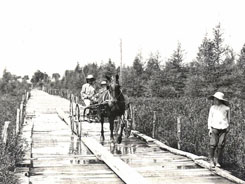
The Plank Road
GRHC - January 4th, 2012
Plank roads evoke the mystique of days gone by, but those old wooden planks held little charm for travelers.
Transcript
“Everyone knows that there is a flourishing city fifty miles north of Kalamazoo, boasting massive blocks of brick and stone, three and four stories high, splendid churches, lumber trade, salt works, steamboats, and its wealthy, enterprising and shrewd business men.” These were the words of the Kalamazoo Gazette in 1851.
It continued, “This city is locally isolated from the business part of the state by the horrible roads intervening between it and the Central and Southern Railroads. Everyone knows that a plank road would not only obviate the difficulties of this “middle passage” of mud and mire, but pay to the stockholders from 20-30 percent on their investments when the long train of loaded teams shall daily pass its toll gates.”
By May of 1852 there were advertisements in the newspaper, “500 men wanted to build the plank road 12 ½ miles from Kalamazoo north, 19 miles from Grand Rapids south, and one bridge across the Kalamazoo River.” The road connected the two cities in 1854, and the trip could be made in one day. Eventually Hwy 131 would follow the same route starting down South Division through Wayland, Shelby, and Plainwell to Kalamazoo.
The plank road and its toll stations were a profitable enterprise, and gave Grand Rapids access to additional farmers and new markets. Suddenly everything changed in 1870 when the Grand Rapids and Indiana Railroad opened. The old oak and pine planks were worn and warped; the rails were fast and smooth.
Full Details
| Title | The Plank Road |
|---|---|
| Creator | GRHC |
| Keywords | Glance at the Past, plank road, Kalamazoo, transportation, roads, radio, WYCE, Grand Rapids, Historical Commission, Podcast |
| Duration | 2:18 |
| Pubdate String | January 4th, 2012 |

 facebook
facebook